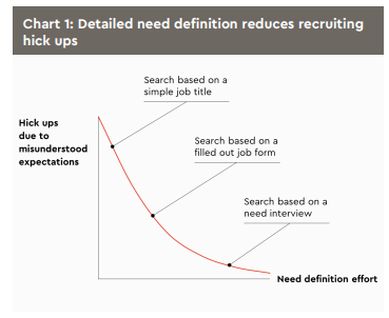Hey there, I'm currently looking for experienced IT project managers and your profile came to my attention." — sent to a Junior Accounting Expert via LinkedIn
We all know these messages on business networks: generic, vague, and not matching the researched role with our profiles. In these cases, we have the strong feeling that we are just another line item of a candidate longlist generated through some keyword search – without any value, neither for us – the candidate – nor for the hiring manager in need of people. This is just one example of a dysfunction that we can observe in recruiting these days and it's a pity, because there are best practice approaches that can really make a difference.
Recruiting is probably the most visible and recognized HR process across companies. It's the gateway into and first point of contact between organizations and future employees. Companies put great effort into continuously improving methods and tools to make recruiters' work more efficient and effective. Yet, many recruiting teams remain trapped between unsatisfied hiring managers, unhappy candidates and rising pressure. Often investments don't show the desired impact. A study among professional firms for instance showed that timeto-hire did not improve in the past 5 years despite significant optimization efforts.1
Numerous projects in which we at Kienbaum supported a wide variety of companies, have given us valuable insights into what distinguishes successful recruiters. We have therefore put together the seven essential features with which outstanding recruiters can meet both the expectations of applicants and the needs of hiring managers – and at the same time keep costs streamlined.
- Understanding the real needs of the hiring manager A Nobel Prize winner once said, "if I had an hour to solve a problem, I'd spend 55 minutes thinking about the problem and 5 minutes thinking about solutions." Although proportions might be different in recruiting, it's worth it for a recruiter to take the time to nail down the precise need – this will save precious time and effort at later stages of the recruiting process (see chart 1). How often do you look for candidates who should be more skilled than needed? Typically, interview feedback reveals that hiring managers actually have a different need than stated at the beginning of the recruiting process.

A proven method to describing the actual need is to engage in a discussion with the hiring manager about how the position that you're going to fill will create value for the business. The process is similar to modern product development, where you start with the customer experience and then work backwards to design a new product. Usually, the answer isn't trivial and further exploring the topic greatly helps establish the role's real scope, identify success factors and derive the most relevant skills. Successful recruiters are able to leverage their knowledge of skill sets that are available in the market, know how rare these skills are and what offers are appropriate for desired candidates to join the team.
Very often the hiring need will significantly evolve alongside the discussion. In some cases, it even leads to the hiring manager realizing that there might be a better solution for their need than hiring a new team member.
Download - Whitepaper_Talent-Acquisition_english.pdf (kienbaum.com)
Footnote
1 Services Performance Insight, LLC (2020). Professional Services Maturity Benchmark Report (p. 115)
The content of this article is intended to provide a general guide to the subject matter. Specialist advice should be sought about your specific circumstances.


